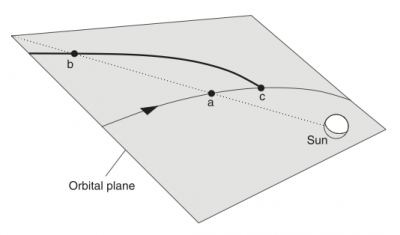Tailcatcher is a service that searches for crossings of comets' ion tails by spacecraft.
When provided with a spacecraft ephemeris as a list of timed positions, the Tailcatcher code will search a database of all known comets for periods when tail crossings may have been possible, if solar wind speeds allow.
Why are Comet Tail Crossings Interesting?

From comet tail crossings, we can learn what happens to cometary material after it has left the region of the comet's nucleus. Comets' ion tails have magnetic field structures that we can also learn about from studying data from magnetometers gathered during tail crossings. Some instruments can directly measure the composition of ions carried in the solar wind, so can provide information on the make-up of the comet from tail material sampled far downstream.
What's needed for a Tail Crossing to Take Place?

- The spacecraft has to be close to a comet’s orbital plane.
- This plane crossing has to be anti-sunward (downstream) of the comet's orbital path.
- The comet nucleus (c) has to have passed upstream of the spacecraft position at (a) before the spacecraft was in that position (hours to weeks, depending on the relative geometry).
- The solar wind speed has to be of the correct magnitude to “carry” the comet pickup ions, i.e. the tail, past the spacecraft at the right time.
The need for all these conditions to be met means that tail crossings are rare. However, they do sometimes occur. The aim of Tailcatcher is to find all possible known ones, and to predict when future tail crossing events will take place. If crossings can be predicted, instruments on spacecraft can be on and in modes that will return the most valuable data from the encounters.
Output from Tailcatcher
The Tailcatcher code is currently undergoing thorough testing.
The columns in the file list the comet of interest, the date of interest at the spacecraft, the minimum angular separation between the comet and the spacecraft position, and the date at which the comet was most closely aligned. The radial distances of the comet and spacecraft, and the distances between them, are then given in Astronomical Units.
In the example output file, it can be seen that Tailcatcher correctly "predicted" the crossings of the tails of C/1996 B2 (Hyakutake) on May 1, 1996, and that of C/2006 P1 (McNaught) in early February 2007.
Acknowledgement
The Tailcatcher project is only possible through the financial support of the Europlanet-2020 Research Infrastructure, funded by the European Commission. Tailcatcher is part of the Europlanet Planetary and Space Weather Services activity.
Header image by David Hardy for PPARC.
 Close
Close

